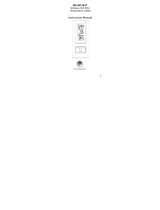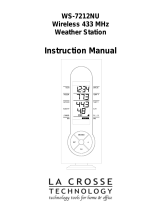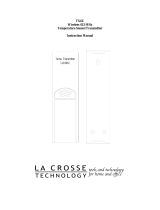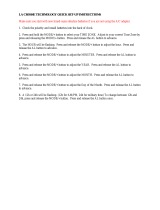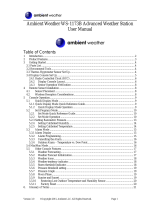Page is loading ...

CONTENTS
Topic Page
Inventory of Contents
About WWVB
Quick Set-Up Guide
Detailed Set-Up Guide
Battery installation
Program Mode
Program Sequence
Function Keys
Setting the LCD Contrast
Time Zone Setting
Daylight Saving Time Setting
Radio-Controlled Time Setting
12/24 Hour Time Setting
Time Setting (WWVB & Manual)
Setting the Year, Day and Month
Setting the Snooze
Setting the Temperature Format
Features
Indoor Temperature
Outdoor Temperature
Minimum & Maximum Records (Indoor, Outdoor, & Resetting)
Alarm (Setting, Snoozing & Stopping)
Viewing date, weekday or alarm time
Additional Remote Control Sending Units (Set-Up, Viewing, &
Operation)
Mounting
Troubleshooting
Maintenance & Care
Specifications
Warranty Information

2
INVENTORY OF CONTENTS
1. The thermo station (Figure 1).
2. One TX6U remote temperature sensor with mounting bracket (Figure 2).
3. Three each, ½” Philips screws.
4. One strip double-sided adhesive tape.
5. Instruction manual and warranty card.
Additional Equipment (not included)
1. Two, fresh AA 1.5V batteries.
2. Two, fresh AA 1.5V batteries.
3. One, Philips screwdriver.
ABOUT WWVB (Radio Controlled Time)
The NIST (National Institute of Standards and Technology—Time and Frequency Division)
WWVB radio station is located in Ft. Collins, Colorado, and transmits the exact time and date
signal continuously throughout the United States at 60 kHz. The signal can be received up to
2,000 miles away through the internal antenna in the Weather Station. However, due to the
nature of the Earth’s Ionosphere, reception is very limited during daylight hours. The weather
station will search for a signal every night when reception is best. The WWVB radio station
derives its signal from the NIST Atomic clock in Boulder, Colorado. A team of atomic
physicists is continually measuring every second, of every day, to an accuracy of ten
billionths of a second per day. These physicists have created an international standard,
measuring a second as 9,192,631,770 vibrations of a Cesium-133 atom in a vacuum. For
more information on the atomic clock and WWVB please see the NIST website at
http://www.boulder.nist.gov/timefreq/stations/wwvb.htm
.
Figure 1
Figure 2

3
QUICK SET-UP GUIDE
Hint: Use good quality Alkaline Batteries and avoid rechargeable batteries.
1. Have the indoor thermo station and remote temperature sensor 3 to 5
feet apart.
2. Batteries should be out of both units for 10 minutes.
3. Place the batteries into the remote temperature sensor first then into
the thermo station.
(All outdoor remotes must be started before the indoor station)
4. DO NOT PRESS ANY BUTTONS FOR 15 MINUTES.
In this time the indoor thermo station and remote temperature sensor will start to talk
to each other and the display will show the indoor temperature and an outdoor
temperature. If the indoor thermo station does not display all information after the
15 minutes please retry the set up as stated above. After all information has been
displayed for 15 minutes you can place your sensor outdoors and set your time.
The remote temperature sensor should be placed in a dry, shaded area. The remote
temperature sensor has a range of 330 feet. Any walls that the signal will have to
pass through will reduce distance. An outdoor wall or window can have up to 30
feet of resistance and an interior wall can have up to 20 feet of resistance. Your
distance plus resistance should not exceed 330 ft. in a straight line.
Note: Fog and mist will not harm your remote temperature sensor but direct rain
must be avoided.
Note: The remote temperature sensor transmits a signal every minute. After the
batteries have been installed, the indoor thermo station will search for the signal for
a duration of 15 minutes. If there is no temperature reading in the OUTDOOR LCD
after 15 minutes, make sure the units are within range of each other, or repeat the
battery installation procedure. If a button is pressed before the indoor weather
station receives the temperature signal, you will need to follow the battery
installation procedure again.
To complete the set up of your wireless temperature station after the 15 minutes have
passed please follow the steps that follow in the Detailed Set-Up Guide.

4
DETAILED SET-UP GUIDE
I. BATTERY INSTALLATION
A. REMOTE TEMPERATURE SENSOR
1. Remove the mounting bracket. The
bracket snaps on and off easily.
2. Remove the battery cover, by sliding the
cover down.
3. Observing the correct polarity install 2 AA
batteries. The batteries will fit tightly (to
avoid start-up problems make sure they do
not spring free).
4. Replace the battery cover by sliding upwards. Be sure battery
cover is on securely.
B. INDOOR THERMO STATION
1. Remove the battery cover. To do
this, insert a solid object in the space
provided at the lower-central
position of the battery cover, then
push up and pull out on the battery
cover.
2. Observe the correct polarity, and
install 2 AA batteries.
3. Replace the battery cover.
Note: Immediately after the batteries have been installed, the
LCD (Liquid Crystal Display) will flash, and a tone will sound.
Within a few seconds the indoor temperature, indoor relative
humidity, will be displayed. If not, remove batteries for 10
seconds and reinstall. If the outdoor temperature is not displayed
within four minutes, remove batteries from both units, wait 10
seconds, and reinstall making sure to install batteries into the
remote temperature sensor first. The time will show -:-- and start
searching for the signal. If it successfully receives the time signal
(usually at night), it will display the correct time (default time-
Battery
com
p
artment
Battery
Cover

5
zone is Eastern). You will need to adjust the time zone to match
your local time.
PROGRAM MODE
Programming Note: If 30 seconds is allowed to pass, or the CH button is
pressed during the programming mode, the unit will confirm/set the last
information entered—the display will stop flashing and return to normal
time-date readings. If you don’t leave the program mode during the
programming of sections III through XI, you can advance to step 4 of the
next program setting. If you do leave the program setting (or want to
program a specific setting) follow each instructional step to program that
setting.
I. PROGRAMMING SEQUENCE AND DEFAULT SETTINGS
The programming sequence and default (factory) settings are as
follows:
LCD Contrast 5
Time Zone -5 (Eastern)
Daylight Saving Time 1 (on)
Radio-controlled time reception ON
12/24-hour time 12
Time 12:00
Year 2003
Day and Month 1.1.
Snooze 10
Temperature Format °F

6
II. FUNCTION KEYS
The Secondary Buttons are located directly below the Primary Buttons, and
behind the shield on the face of the unit. To access the Secondary Buttons:
place a solid object in the slot (above the shield) and gently pull out and
down.
III. SETTING THE LCD CONTRAST
1. Press and hold the SET button for 5 seconds.
2. “LCD” will show in the time LCD and the number setting will
flash.
Note: There are 8 LCD contrast levels to choose from—“Lcd 0” is
the lightest, and “Lcd 7” is the darkest.
3. Press and release the IN button to select the level you desire.
4. Press and release the SET button to confirm and advance to
the Time Zone setting.
Primary Buttons
Secondary Buttons

7
IV. TIME ZONE SETTING
1. Press and hold the SET button for 5 seconds.
2. “LCD” will show in the time LCD and the number setting
will flash.
3. Press and release the SET button again.
4. The time zone will flash in the date LCD.
5. Press and release the IN button to select your time zone.
Note: When a time zone for the U.S. is selected the corresponding
abbreviation will appear above the time (please see the table). It is
possible to select any time zone from –12 GMT to +12 GMT (for
example to see the time in another country)
TIME ZONES
GMT 0
Atlantic -4
EST; Eastern -5
CST; Central -6
MST; Mountain -7
PST; Pacific -8
ALA; Alaska -9
HAW; Hawaii -10
6. Press and release the SET button to confirm and advance to
the Daylight Saving Time setting.

8
V. DAYLIGHT SAVING TIME (DST) SETTING
1. Press and hold the SET button for 5 seconds.
2. “LCD” will show in the time LCD and the number setting will
flash.
3. Press and release the SET button twice.
4. “DST” will appear in the date LCD and either “1” or “0” will
flash.
5. Press and release the IN button to select DST on or off.
“DST 0” indicates that the feature is off and the WWVB will not
change times automatically. “DST 1” indicates that the feature is
on and the WWVB will change times automatically.
Note: Some locations (Arizona and parts of Indiana) do not
follow Daylight Saving Time, and should select “DST 0.”
6. Press and release the SET button to confirm and advance to
the radio-controlled time on/off setting.
VI. RADIO-CONTROLLED TIME ON/OFF SETTING
1. Press and hold the SET button for 5 seconds.
2. “LCD” will show in the time LCD and the number setting will
flash.
3. Press and release the SET button three times.
4. “RCC” will appear in the date LCD and “ON” or “OFF” will
flash in the time LCD.
5. Press and release the IN button to select radio-controlled time
on or off.

9
6. Press and release the SET button to confirm and advance to
the 12/24-hour time setting.
VII. 12 OR 24 HOUR TIME SETTING
1. Press and hold the SET button for 5 seconds.
2. “LCD” will show in the time LCD and the number setting will
flash.
3. Press and release the SET button four times.
4. “12h” or “24h” will flash in the time LCD.
5. Press and release the IN button to select 12 or 24-hour time
format.
Note: When in the 12-hour format “P.M.” will appear to the left
of the hour in the time LCD between the hours of noon and
midnight.
6. Press and release the SET button to confirm and advance to
the time setting.
VIII. TIME SETTING
There are two methods by which the time and date can be set:
A) Automatically via WWVB reception, or
B) Manually.
A. WWVB (Remote Control Time)
This method requires you to do nothing, except wait for the signal to be
received, and to select a time zone. Reception usually takes
approximately 10 minutes during optimal conditions. The best

10
condition for reception is at night, between midnight and 6:00 am—
when there is less atmospheric interference. To keep your time as
accurate as possible, the thermo station conducts a WWVB search
every night between these hours, and overrides any manually set time.
The WWVB tower icon (appearing in the TIME LCD) will flash when
a signal-search is in progress and a signal is being received, and will
remain steady when the signal has been received. If the WWVB time
has not been received after 10 minutes of battery installation, you may
manually set the time or leave the time function alone (reception will
occur regardless).
B. MANUAL TIME SETTING
Note: When in the 12-hour format “P.M.” will appear to the left of the
hour in the time LCD between the hours of noon and midnight.
1. Press and hold the SET button for 5 seconds.
2. “LCD” will show in the time LCD and the number setting will
flash.
3. Press and release the SET button five times.
4. The time will flash in the time LCD.
5. Press and release the IN button to advance the hours.
6. Press and release the OUT button to advance the minutes.
7. Press and release the SET button to confirm and advance to the
year setting.

11
IX. SETTING THE YEAR, DAY AND MONTH
Note: Reception of the WWVB signal will also set the date and day.
The reception of the signal will override any programmed date and day.
1. Press and hold the SET button for 5 seconds.
2. “LCD” will show in the time LCD and the number setting will
flash.
3. Press and release the SET button six times.
4. The year will flash in the date LCD.
5. Press and release the IN button to advance the year.
6. Press and release the SET button to confirm and advance to the
day/month setting.
7. The day and month will flash in the date LCD.
8. Press and release the IN button to advance the month in 12h time
format display (for date in 24h time format display) .
9. Press and release the OUT button to advance the day in 12h time
format display (for month in 24h time format display).
10. Press and release the SET button to confirm and advance to the
snooze setting.
Note:
Month, Date (for 12h time format display)
Date, Month (for 24h time format display)

12
X. SETTING THE SNOOZE
1. Press and hold the SET button for 5 seconds.
2. “LCD” will show in the time LCD and the number setting will
flash.
3. Press and release the SET button 8 times.
4. The snooze duration will flash in the date LCD.
5. Press and release the IN button to advance the duration time of the
snooze.
6. Press and release the SET button to confirm and advance to the
temperature format setting.
Note: The snooze can be set to OFF, 5, 10, 15, 20, 25 or 30 minutes.
XI. SELECTING °F OR °C
1. Press and hold the SET button for 5 seconds.
2. “LCD” will show in the time LCD and the number setting will
flash.
3. Press and release the SET button nine times.
4. Either ”°F” or “°C” will flash in the time LCD.
5. Press and release the IN button to select the temperature format.
6. Press and release the SET button to confirm and advance to the
forecast sensitivity setting.
XII. SETTING THE FORECAST SENSITIVITY
Note: This is an unused function of the thermo station and should be
disregarded. The setting has no bearing on the operation. Please press and
release the SET button to exit the manual settings.

13
FEATURES OF THE TX2000
I. INDOOR TEMPERATURE
The current indoor temperature is displayed in the INDOOR LCD.
II. OUTDOOR TEMPERATURE
The temperature received from the remote temperature sensor is viewed in
the OUTDOOR LCD. When there is more than one remote sensor unit in
operation, a “boxed” number will appear to the right of the temperature.
This indicates which remote sensor unit (1, 2, or 3) is currently displaying
its data in the OUTDOOR LCD. (This feature is explained in further detail
in section V—Adding Remote Temperature Sensors).
III. MINIMUM AND MAXIMUM TEMPERATURE RECORDS
The TX2000 keeps a record of the MINIMUM and MAXIMUM
temperature, and the time and date of their occurrence—for both the indoor
and outdoor modes.
A. VIEWING THE INDOOR TEMPERATURE RECORDS
1. Press the IN button once. “MIN” appears above the indoor
temperature and the LCD will flash, indicating that the
minimum temperature and the time and date of occurrence are
WWVB Tower Icon
(indicates time reception)
Satellite icon (indicates
outdoor transmission)
Alarm icon
Low battery icon

14
displayed. The minimum records will display for 30 seconds
before returning to the normal display mode.
2. Press the IN button again (once while “MIN” is still displayed,
twice otherwise). “MAX” appears above the indoor
temperature and the LCD will flash, indicating that the
maximum temperature and the time and date of occurrence are
displayed.
3. While “MAX” is still displayed press the IN button again to
return to the current data display. Or you can wait 30
seconds, during either the minimum or the maximum readings,
and the unit will automatically return to current data readings.
B. VIEWING THE OUTDOOR TEMPERATURE
RECORDS
1. Press the OUT button once. “MIN” appears above the
outdoor temperature and the LCD will flash, indicating that
the minimum temperature and the time and date of occurrence
are displayed. The minimum records will display for 30
seconds before returning to the normal display mode.
2. Press the OUT button again (once while “MIN” is still
displayed, twice otherwise). “MAX” appears above the
outdoor temperature and the LCD will flash, indicating that
the maximum temperature and the time and date of occurrence
are displayed.
3. While “MAX” is still displayed press the OUT button again to
return to the current data display. Or you can wait 30
seconds, during either the minimum or the maximum readings,
and the unit will automatically return to current data readings.

15
C. RESETTING THE MIMIMUM AND MAXIMUM
RECORDS
1. All the Indoor records (minimum and maximum) will be reset
after the IN button is pressed and held for 5 seconds.
2. All the Outdoor records (minimum and maximum) will be
reset after the OUT button is pressed and held for 5 seconds.
IV. ALARM FUNCTION
A. SETTING THE ALARM (alarms 1 and 2)
Note:
There are two alarms that can set. Each alarm will sound
for a complete duration of 2 minutes.
1. Press and hold the AL1 button for 5 seconds, or until the
alarm-time display flashes in the DATE LCD.
2. Press the IN button to set the alarm hours, and the OUT button
to set the alarm minutes.
3. Press the AL1 button, or wait 15 seconds for the unit to
automatically confirm the alarm time and return to display the
date in the DATE LCD as normal.
4. The ((1)) icon, appearing in the DATE LCD, indicates that the
alarm is set to sound at the programmed time.
5. Programming the alarm time automatically activates the alarm
to sound at the programmed time. To deactivate the alarm,
press the AL1 button (removing the ((1)) icon from the
screen). To reactivate the alarm, press the AL1 button again.
6. After each activation or deactivation, the programmed alarm
time is displayed. Wait 15 seconds and the date will display
in the DATE LCD again.
7. To set, activate, and deactivate alarm 2, follow the directions
above for alarm 1—using the AL2 button instead of the AL1

16
button. The ((2)) icon will represent activation and
deactivation of Alarm 2.
B. SNOOZING AND STOPPING THE ALARM
1. Press and release the SNZ button to activate the snooze
function.
2. To turn the alarm off completely press any button other than
the SNZ button.
3. The snooze function will last for the length it was set for in
the set-up mode before the alarm begins to sound again.
Either the ((1)) or the ((2)) icon will flash during the snooze
mode depending on which of the alarms is in the snooze
mode.
V. VIEWING DATE, WEEKDAY OR TIME ALARM
The date display section can be set to view the date, weekday, time alarm ((1)) and
((2)).
To set the LCD to display alarm time, press the “DATE” button and toggle through
display choices.
VI. ADDING REMOTE TEMPERATURE SENSORS (OPTIONAL)
The TX2000 is able to receive signals from 3 different remote temperature
sensors. The remote temperature sensor model(s) that you choose will
come with their own set of instructions—follow these instructions for a
complete guide to setting up. Following are some brief instructions for the
basic set-up of remote temperature sensor units with the TX2000. These
extra sensors can be purchased through the same dealer as this unit. A
TX6U will monitor temperature only, a TX4U will monitor the temperature
and humidity, a TX3U will monitor temperature and display the
temperature on its LCD, and the TX3UP will monitor the temperature via a
probe for use in pools, spas, etc.
Note: When setting up multiple units it is important to remove the batteries
from all existing units in operation, then to insert batteries first into all the
remote temperature sensor units, and in numeric sequence. Second install
batteries into the thermo station. Transmission problems will arise if this is
not done correctly and if the total time for set-up exceeds 6 minutes.

17
A. SET-UP OF MULTIPLE UNITS
1. It is necessary to remove the batteries from all units currently
in operation.
2. Remove the battery covers to all remote temperature sensor
units.
3. Place all remote temperature sensor units in a numeric
sequential order.
4. In sequential order, install batteries (follow the same battery
installation procedures seen in section I. A) of the Detailed
Set-Up Guide).
5. Install batteries into the indoor thermo station.
6. Follow the Detailed Set-Up Guide for programming and
operating instructions.
B. VIEWING AND OPERATING WITH MULTIPLE
REMOTE TEMPERATURE SENSOR UNITS
1. To view the temperature of a different remote temperature
sensor unit, press and release the CH button. A shift from one
“boxed” number to the next should be observed in the
OUTDOOR LCD.
2. To view the Minimum/Maximum temperature: first select
which remote temperature sensor to read data from (indicated
by the “boxed” number), then press the OUT button. Pressing
this button once will display the minimum temperature, and
the date and time the data was recorded. Pressing this button
a second time (while “MIN” is still displayed, otherwise press
the button twice) will display the same data for the maximum
recordings.
3. To reset the Minimum/Maximum readings, it is necessary to
select which remote temperature sensor you wish to reset.
Press and hold the OUT button for 5 seconds, the records for
the selected remote temperature sensor unit will be reset.
MOUNTING
Note: Before permanently mounting ensure that the thermo station is able
to receive WWVB signals from the desired location. Also, extreme and

18
sudden changes in temperature will decrease the accuracy of the indoor
weather station, and changes in elevation will result with inaccurate
weather forecasting for the next 12 to 24 hours. These changes will require
a 12 to 24 hour wait before obtaining reliable data. To achieve a true
temperature reading, avoid mounting where direct sunlight can reach the
remote temperature sensor or indoor weather station. While the remote
temperature sensor is weather proof, avoid submersion in water or snow.
We recommend that you mount the remote temperature sensor on an
outside North-facing wall. The sending range is 330ft—obstacles such as
walls, concrete, and large metal objects can reduce the range. Place both
units in their desired location, and wait approximately 15 minutes before
permanently mounting to ensure that there is proper reception. The thermo
station should display a temperature in the OUTDOOR LCD within 4
minutes of setting up.
I. THE REMOTE TEMPERATURE SENSOR
The remote temperature sensor can be mounted in two ways:
• with the use of screws, or
• using the adhesive tape.
A. MOUNTING WITH SCREWS
1) Remove the mounting bracket from the remote
temperature sensor.
2) Place the mounting bracket over the desired location.
3) Through the three screw holes of the bracket, mark the
mounting surface with a pencil.
4) Screw mounting bracket onto the mounting surface.
Ensure that the screws are flush with the bracket.
5) Insert the remote temperature sensor into the bracket.
B. MOUNTING WITH ADHESIVE TAPE
1) With a nonabrasive solution, clean and dry the back
of the mounting bracket and the mounting surface to
ensure a secure hold. The mounting surface should
be smooth and flat.
2) Remove the protective strip from one side of the
tape.
3) Adhere the tape to the designated area on the back of
the mounting bracket.

19
4) Remove the protective strip from the other side of the
tape.
5) Position the remote temperature sensor in the desired
location, ensuring that the indoor weather station can
receive the signal.
II. THE INDOOR THERMO STATION
The indoor thermo station can be mounted in two ways:
• with the table stand or,
• on the wall with the use of a wall hanging screw (not
included).
A. USING THE TABLE STAND
The indoor thermo station comes with the table stand
already mounted. If you wish to use the table-stand all
that is required is to place the indoor weather station in
an appropriate location.
B. WALL MOUNTING
1) Remove the table-stand. To do this, pull down on the
stand from the rear and rotate forward.
2) Fix a screw (not included) into the desired wall,
leaving approximately 3/16 of an inch (5mm)
extended from the wall.
3) Place the indoor thermo station onto the screw using
the hanging hole on the backside.
4) Gently pull the indoor thermo station down to lock the
screw into place.
TROUBLESHOOTING
NOTE: For problems not solved, please contact La Crosse Technology.
Problem: No reception of WWVB time signal.
Solution: 1) Wait overnight for signal.
2) Be sure indoor thermo station is at least 6 feet from any electrical devices, such
as televisions, computers, or other radio-controlled clocks.
3) Remove batteries for five minutes, reinsert and leave the unit alone overnight
without pressing buttons.
4) If there are still problems, contact La Crosse Technology

20
Problem: Hour is incorrect (minute and date are correct)
Solution: Be sure correct time zone and daylight saving time settings are selected.
Problem: The LCD is faint
Solution: 1) Set the LCD contrast to a higher number
2) Replace the batteries
Problem: No outdoor temperature is displayed.
Solution: 1) Remove all batteries, reinsert into remote temperature sensor first, then into the
indoor thermo station.
2) Place remote temperature sensor closer to the indoor thermo station.
3) Be sure all batteries are fresh.
4) Place remote temperature sensor and indoor thermo station in position so the
straight-line signal is not passing through more than two or three walls.
Problem: Temperatures do not match if units are placed next to each other.
Solution: Each temperature sensor is manufactured to be accurate to within 1 degree plus or
minus and under normal conditions, so two sensors could be as much as 2 degrees
different. However, the difference can be exaggerated further because the sensors
are designed for different working environments. The indoor sensor is less
responsive to ambient air currents because of the shielding effect of the display's
case. In addition, the case can act as a heat sink to absorb and store heat from
external sources (i.e. handling of the case or radiant heat). Also, the much greater
range of the outdoor temperature sensor requires a different calibration curve than
the indoor range. Error is usually greater at the extreme ends of a range, making it
harder to compare different ranges with different curves. Under non-laboratory
conditions, it is difficult to compensate for the above factors and obtain an accurate
comparison.
MAINTENANCE AND CARE INSTRUCTIONS
• Extreme temperatures, vibration, and shock should be avoided to prevent
damage to the units.
• Clean displays and units with a soft, damp cloth. Do not use solvents or
scouring agents; they may mark the displays and casings.
• Do not submerge in water.
• Immediately remove all low powered batteries to avoid leakage and
damage.
• Opening the casings invalidates the warranty. Do not try to repair the unit.
Contact La Crosse Technology for repairs.
SPECIFICATIONS
/

